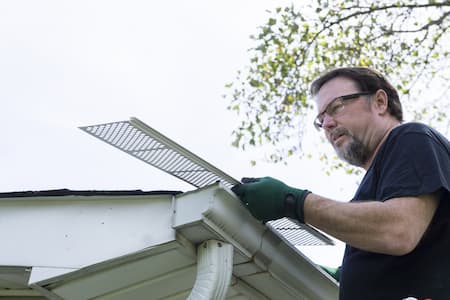Top 5 Gutter Guard Types

Gutters help protect the foundation of your home by moving rainwater into your yard. This is an important job. Unfortunately, gutters are shaped in a way that can lead to catching twigs, leaves, and other contaminants as they run off your roof. Over time, this can lead to clogging and breaking in your gutter.
The best way to protect your gutters from clogging is to invest in professional gutter guards. Gutter guards help keep debris from finding its way into your gutter system. It can also cut down on how often you need to invest in professional gutter cleaning. The pressure washing experts at Senoia Softwash explain the top 5 gutter guard types so you can choose the best options for your home.
1. Screen
Gutter guards that use screens are often made from metal or plastic. These guards are shaped into grids to keep leaves and other debris out of the gutter trough. This option is great because it's a simple system to keep debris from clogging your system.
To install, the bottom layer of your shingles is lifted and the screen is laid down underneath to hold it in place. The shingles are then put back down to hold the screen over your gutter. This is one of the cheapest gutter guard options available.
Unfortunately, screens aren't bolted down, which means they can lift or dislodge with high winds. The installation process might also invalidate some roof warranties.
2. Micro Mesh
Micro mesh is a similar gutter guard option to screens. The micro mesh allowed water to go through while stopping twigs, branches, and other natural debris.
This option can be installed the same as a screen, by slipping the edge of the micro mesh under the first layer of shingles. However, it can also be installed by snapping the guard directly onto the gutter or attached to the vertical strip just above the gutter.
Micro mesh guards can be made from everything from plastic to steel. This means that the cost is up to you depending on what gutter guard options you want. While micro mesh does well to filter larger debris, you'll need to make sure you're keeping up on interior cleaning. Fine dirt particles can still find their way into your gutter system.
3. Reverse Curve
Reverse curve guards are lightweight and appear as a curve atop your gutter trough. The water flows over the top of the reverse curve guard. Any natural debris keeps falling to the ground while the rainwater runs down into the interior of your gutter trough.
The cost of reverse curve guards is higher because the installation process requires a professional. If these guards aren't professionally installed, the water can run over the side of the gutter and find its way into your foundations.
4. Brush
A brush gutter guard looks like a large pipe cleaner that lays in the interior of your gutter trough. This process is simple because you just cut the brush to fit your gutter lengths. Brush gutter guards are cheaper than most options and easy to install, which makes them a lifesaver for DIY'ers.
5. Foam
Foam gutter guards are also easy to install and inexpensive. This option is basically a foam block cut into a triangle that sits in the trough of your gutter system. The foam is easy to cut to fit your gutters and doesn't require nails or screws.
Hire A Professional
If you're thinking of installing gutter guards on your home, it's a great idea to invest in professional gutter cleaning first. Our gutter cleaning process removes dirt and debris from your gutter system. This gives you a blank canvas to work with while you get your gutter guards installed. To learn more about how our gutter cleaning experts can help with your gutter guard project, call Senoia Softwash today at 678-588-7822 to set up an appointment.
Call Us Today For Expert Pressure Washing In Senoia & The Surrounding Areas!